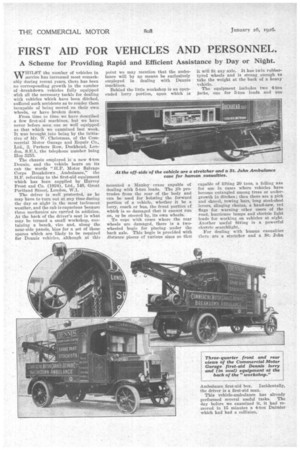FIRST AID FOR VEHICLES AND PERSONNEL.
Page 12

If you've noticed an error in this article please click here to report it so we can fix it.
A Scheme for Providing Rapid and Efficient Assistance by Day or Night.
WHILST the number of vehicles in service has increased most remarkably during recent years, there has been no corresponding growth in the number of -breakdown vehicles fully equipped With all the necessary tackle for dealing with vehicles which have been ditched, suffered such accidents as to render them incapable of being moved on their own wheels, or have broken down.
From time to time we have described a few first-aid machines, but we have never 'before seen one so well equipped as that which we examined last week. It was brought into being by the initiative of Mr. W, Christmas, of the Commercial Motor Garage and Repair Co., Ltd., 2, Parkers Row, Dockhead, London, S.E.1, the telephone number being Hop 5255.
The chassis employed is a new 4-ton Dennis, and the vehicle bears on its cab the words "Ef.P. Motor Salvage Corps Breakdown_ Ambulance," the H.P. referring to the first-aid equipment which has been supplied by Harvey Frost and Co. (1924), Ltd., 148, Great Portland Street, London, W.1.
The driver is well protected, as he may have to turn out at any time during the day or night in the most inclement weather, and the cab is capacious because three mechanics are carried in addition. At the back of the driver's seat is what may be termed a small workshop, containing a bench, vice and, along the near-side panels, bins for a set of those spares which are likely to be required for Dennis vehicles, although at this
point we may mention that the ambulance will by no means be exclusively employed in 'dealing with Dennis machines.
Behind the little workshop is an openended lorry portion, upon which ;s mounted a Manley crane capable of dealing with 5-ton loads. The jib protrudes from the rear of the body and can be need for hoisting the forward portion of a vehicle, whether it be a lorry, coach or bus, the front portion cf which is so damaged that it cannot run on, or be steered by, its own wheels.
To cope with cases where the rear wheels are damaged, there is a twowheeled bogie for plaeiug under the back axle. This bogie is provided with distance pieces cf various sizes so that it will fit any axle. It has twin rubbertyred wheels and is strong enough to take the weight at the back of a heavy ehiele.
The equipment includes two 4-ton jacks, one for 5-ton loads and one capable of lifting 20 toils, a felling axe for use in cases where vehicles have become entangled among trees or undergrowth in ditches ; then there are a pick and shovel, towing bars, long steel-shod levers, slinging chins, a hand-saw, red flags for warning other users of the road, hurricane lamps and electric light leads for working on vehicles at night. Another useful fitting is a powerful electric searchlight.
For dealing with human casualties there are a stretcher and a St. John Ambulance first-aid box. Incidentally, the driver is a first-aid man.
This vehicle-ambulance has already performed several useful tasks. The day before we examined it, it had removed in 15 minutes a 4-ton Daimler which had had a collision.




























